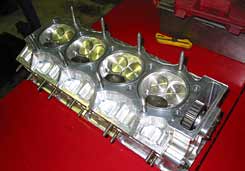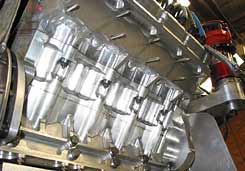| 
 ith the recent announcement by the NHRA that
a moratorium would be put in place on all further major engine
component development and a spec engine will likely be introduced
in the near future, a debate has broken out as to whether
this will actually achieve NHRA’s goals of constraining
costs and improving safety by limiting further performance
gains. One side of the fence says a spec engine is inevitable
and anything that improves the racing should be done, the
other points out that strict spec rules seldom if ever control
costs – in fact often costs increase as performance
gains are harder (and hence more expensive) to find, and
failure rates increase as design limits are exceeded more
frequently. ith the recent announcement by the NHRA that
a moratorium would be put in place on all further major engine
component development and a spec engine will likely be introduced
in the near future, a debate has broken out as to whether
this will actually achieve NHRA’s goals of constraining
costs and improving safety by limiting further performance
gains. One side of the fence says a spec engine is inevitable
and anything that improves the racing should be done, the
other points out that strict spec rules seldom if ever control
costs – in fact often costs increase as performance
gains are harder (and hence more expensive) to find, and
failure rates increase as design limits are exceeded more
frequently.
As a counter point to NHRA’s argument,
a little heard of team in Australia has been busy building
it’s own Top Fuel engines for over a decade. Coming
from a family with a powerboat racing background, Terry Sainty’s
first real drag car was an Alcohol Dragster powered by one
of his father Stan’s 32 valve OHC motors from the boat
racing days. On the water the Sainty 4-valve motor ran quite
well and on alcohol a 6.8 lap was their best effort. Soon,
however, due to the rules of the day the team was forced
to run in Top Fuel, and on nitro the motor struggled to a
best of 6.1.
 |
 |
Taking the lessons learnt from the 4-valve
motor, and what they could glean from similar efforts such
as the McGee quad-cammer, combined with advice from several
knowledgeable fuel tuners, the Sainty team headed by Terry’s
father Stan began working on a new design, intended to blend
the best aspects of multi-valve technology with traditional
fuel engines. Also tipped into the mix were some features
from Big Block Chevs and Fords. High on the wish list was
avoiding the more serious problems inherent in existing designs,
which Sainty Speed Works spends a lot of time fixing for
customers.
It was designed to be bullet proof, powerful,
economical to run, and yet easy to work on - all essential
ingredients in Top Fuel racing.
 Starting with the short block, the Sainty BTV
(Billet Three Valve) motor’s block is made in three
sections from heat treated 6061TS billets to permit easier
machining and simplify repair in the event of failure - each
cylinder bank bolts to the centre crankcase and can be easily
removed. The block has 4.9” bore spacing, which allows
for better cylinder wall stability and head gasket clamping,
as well as an improved bore/stroke ratio. An 11” deck
height improving clearances, and it is 1” shorter than
a Hemi, with the thrust bearing on the rear main. Starting with the short block, the Sainty BTV
(Billet Three Valve) motor’s block is made in three
sections from heat treated 6061TS billets to permit easier
machining and simplify repair in the event of failure - each
cylinder bank bolts to the centre crankcase and can be easily
removed. The block has 4.9” bore spacing, which allows
for better cylinder wall stability and head gasket clamping,
as well as an improved bore/stroke ratio. An 11” deck
height improving clearances, and it is 1” shorter than
a Hemi, with the thrust bearing on the rear main.
|
